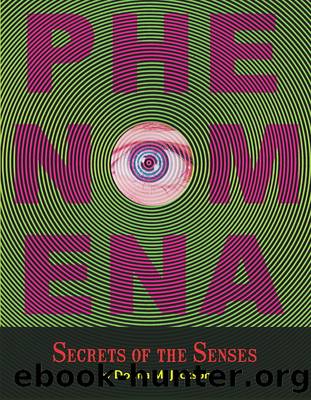Phenomena by Donna M. Jackson

Author:Donna M. Jackson [JACKSON, DONNA M.]
Language: eng
Format: epub
Tags: JNF008000
ISBN: 9780316039888
Publisher: Little, Brown Books for Young Readers
Published: 2008-09-01T00:00:00+00:00
Some synesthetes, such as Sean Day, experience sensations such as colors and shapes outside their bodies. When Sean eats food, his colors appear at about armâs length, âa little higher than eye level and slightly to the left.â His musical colors usually appear about halfway between his body and the source of the music, whether thatâs two feet away or fifty.
© AP Wide World Photos
In 1880, Sir Francis Galton published a report about the phenomenon, and while scientists showed a brief flurry of interest, many dismissed it until recently. Some saw it as a product of a vivid imagination, a cry for attention, or drug use. Drugs arenât totally implausible, says neurologist Dr. Richard Cytowic, who âaccidentally rediscoveredâ the condition in 1980 when a dinner host commented that the meal wasnât ready because there âwerenât enough points on the chicken.â Several drugs can cause temporary synesthesia-like effects, he says, âbut [synesthetes] experience this all the time, naturally throughout their whole life. As children, theyâre shocked to discover that the rest of the worldâs not like them.â
No single diagnostic test exists for the various forms of synesthesia. However, Dr. Cytowic has identified general clinical characteristics of the condition, which include:
Involuntary and automatic: âIt happens to you, as opposed to you doing anything specialâ to produce it, he says. Carol recognized her blended senses at about age four. Growing up, sheâd ask people questions such as, âWhat color is your three?â and theyâd look at her confused. Until recently, when she realized not everyone had her skill, Carol thought it was something she chose to do for enjoyment. âIt never occurred to me that I had no choice in the matter,â she says.
Consistent and generic: âOnce established in childhood, synesthetic associations remain stable throughout life,â says Dr. Cytowic. If A is blue in your alphabet, then itâs always blue. If New York tastes like chocolate cake, then it always tastes like chocolate cake. Synesthesia also is generic in that the experiences are not complex, he says. âWhere I might say listening to Beethoven makes me see sheep gamboling through a meadow . . . synesthetes would say I see zigzags, grids, or circles moving off to the right. Perceptually, itâs very elementary.â
Memorable: The sensations that accompany a particular word, shape, or piece of music generally make it easier for synesthetes to remember them. For example, some use the colors they see to recall peopleâs names or phone numbers or to identify keys on the piano. At times, however, the condition can complicate matters. Some synesthetes find it frustrating, for instance, when their colored numbers or letters donât match those of the outside world. âIf I park my car in a garage, and the number of the floor is [painted] in the wrong color,â says Carol, âI have to make a conscious effort to remember one [color] or the other.â
Despite such hurdles â and a few unpleasant associations â synesthesia is usually highly pleasurable for people, says Dr. Cytowic. Many integrate their experiences into creative pursuits, such as art, writing, and music.
Download
This site does not store any files on its server. We only index and link to content provided by other sites. Please contact the content providers to delete copyright contents if any and email us, we'll remove relevant links or contents immediately.
| Board Games | Card Games |
| Magic | Party Games |
| Puzzles | Questions & Answers |
| Travel | Video & Electronic |
| Word Games |
The Code Book by Simon Singh(3077)
The Checklist Manifesto by Atul Gawande(2781)
Everything, Everything by Nicola Yoon(2601)
If It Bleeds by Stephen King;(2380)
Tales of the Unexpected by Roald Dahl(2339)
One Fish Two Fish Red Fish Blue Fish by Dr Seuss(2328)
Easy Electronics by Charles Platt(2282)
The Astronomy Book by DK(2114)
We're All Wonders by R. J. Palacio(2062)
Science Experiments You Can Eat by Vicki Cobb(1839)
Fashion 101 by Erika Stalder(1806)
The Art of Flight by unknow(1805)
Minecraft by Mojang Ab(1744)
Martin Gardner's Science Magic by Martin Gardner(1689)
Weather by Jenny Offill(1675)
Mission Python by Sean McManus(1655)
Romancing the Nerd by Leah Rae Miller(1650)
The Boy, The Mole, The Fox and The Horse by Mackesy Charlie(1648)
Good with Words by Patrick Barry(1602)
